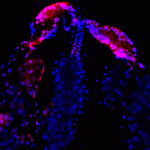Link to Pubmed [PMID] – 31815960
Link to DOI – 10.1371/journal.ppat.1008199
PLoS Pathog 2019 Dec; 15(12): e1008199
More than half of the world population is at risk of dengue virus (DENV) infection because of the global distribution of its mosquito vectors. DENV is an envelope virus that relies on host lipid membranes for its life-cycle. Here, we characterized how DENV hijacks the mosquito lipidome to identify targets for novel transmission-blocking interventions. To describe metabolic changes throughout the mosquito DENV cycle, we deployed a Liquid chromatography-high resolution mass spectrometry (LC-HRMS) workflow including spectral similarity annotation in cells, midguts and whole mosquitoes at different times post infection. We revealed a major aminophospholipid reconfiguration with an overall early increase, followed by a reduction later in the cycle. We phylogenetically characterized acylglycerolphosphate acyltransferase (AGPAT) enzyme isoforms to identify those that catalyze a rate-limiting step in phospholipid biogenesis, the acylation of lysophosphatidate to phosphatidate. We showed that DENV infection decreased AGPAT1, but did not alter AGPAT2 expression in cells, midguts and mosquitoes. Depletion of either AGPAT1 or AGPAT2 increased aminophospholipids and partially recapitulated DENV-induced reconfiguration before infection in vitro. However, only AGPAT1 depletion promoted infection by maintaining high aminophospholipid concentrations. In mosquitoes, AGPAT1 depletion also partially recapitulated DENV-induced aminophospholipid increase before infection and enhanced infection by maintaining high aminophospholipid concentrations. These results indicate that DENV inhibition of AGPAT1 expression promotes infection by increasing aminophospholipids, as observed in the mosquito’s early DENV cycle. Furthermore, in AGPAT1-depleted mosquitoes, we showed that enhanced infection was associated with increased consumption/redirection of aminophospholipids. Our study suggests that DENV regulates aminophospholipids, especially phosphatidylcholine and phosphatidylethanolamine, by inhibiting AGPAT1 expression to increase aminophospholipid availability for virus multiplication.

